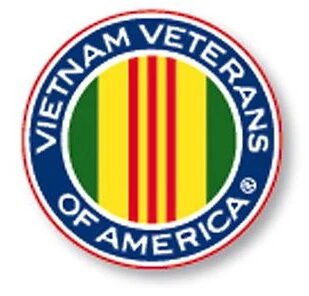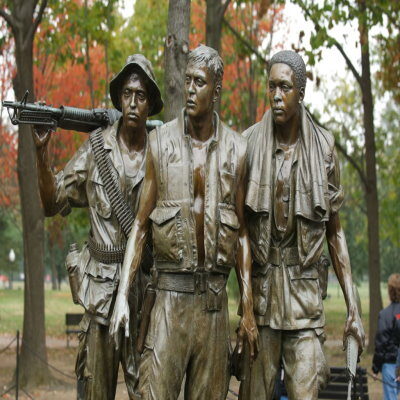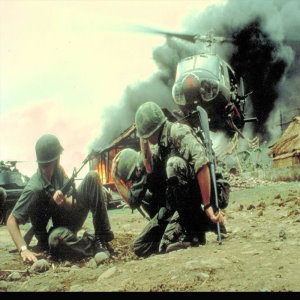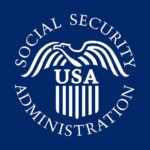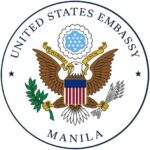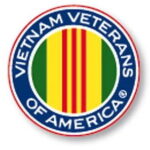
Support to South Vietnam
The war in Vietnam was a much larger event than most people realized. For starters, forty nations provided assistance to South Vietnam ranging from economic and technical assistance to educational and humanitarian contributions. Hundreds of civilians from countries around the world worked in Vietnam as doctors, teachers and technical specialists. Eight Free-World nations also provided military assistance: The United States, the Republic of Korea, Thailand, Australia, New Zealand, the Philippines, the Republic of China, and Spain – their flags flew proudly alongside the colors of the Republic of Vietnam at the Free-World headquarters in Saigon. The military contributions of these nations included combat troops, army medical teams, and individual political warfare advisers. Most people think that the United States, Australia and Korea were the only allied troops fighting in that war. So let’s take a look at each of them…
The Republic of Korea
They started landing troops in the RVN during September and October 1965. By the end of 1966, RoK had the second largest foreign military force in Vietnam behind the U.S.
They also did not come to advise anyone. They came to fight against the NVA and VC.
The Capital Division, affectionately called by the Americans the Tiger Division, arrived at Qui Nhon during November 1965, initially with two regiments. The area was chosen, among other reasons, because it was not populated and would therefore not take agricultural land away from the local inhabitants. It was, moreover, high ground that would not be adversely affected by the rains. These circumstances would give the Koreans an opportunity to spread out their command post as much as they wished and allow the first troop units some training in operating against the enemy.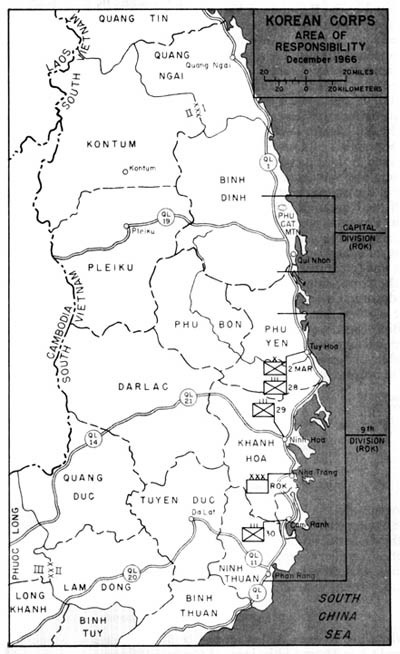 The Capital “Tiger” Division was responsible for Binh Dinh Province, while the 9th “White Horse” Division was responsible for Phu Yen, Khanh Hoa and Ninh Thuan provinces, all in II Corps. The Blue Dragon Marine Brigade was positioned at Cam Ran Bay, in southeastern Khan Hoa Province, then moved to Tuy Hoa, then moved to I Corps. Presented by Shukhevych in Open Diary.
The Capital “Tiger” Division was responsible for Binh Dinh Province, while the 9th “White Horse” Division was responsible for Phu Yen, Khanh Hoa and Ninh Thuan provinces, all in II Corps. The Blue Dragon Marine Brigade was positioned at Cam Ran Bay, in southeastern Khan Hoa Province, then moved to Tuy Hoa, then moved to I Corps. Presented by Shukhevych in Open Diary.
By June of 1966 the Capital Division controlled all the area north of Qui Nhon to the east of Highway 1 and up to the base of Phu Cat Mountain. It extended its control also to the north and south of Highway 19 up to the pass leading into An Khe. Working south along Highway 1 down toward Tuy Hoa and within the province of Binh Dinh, the Capital Division sent out reconnaissance parties and carried out small operations as far south as the border between Binh Dinh and Phu Yen.

Soldiers of the ROK White Horse Division in Vietnam.

South Korean Marine
During the Vietnam War, the Republic of Korea sent more combat troops to South Vietnam than any other American ally. At their peak, they had close to 50,000 boots on the ground with over 300,000 served through 1973. About 5,000 died. This was the ROK’s first military action abroad.
The Capital and Ninth divisions were withdrawn from South Vietnam in March 1973. South Korea’s loyalty to the American war effort in South Vietnam, even though most Korean officials did not think the war was politically winnable, was a direct function of the close relationship existing between the two countries since the Korean War (1950-53). Many American soldiers have claimed that the extremely disciplined ROK Marines were ruthless and a difficult force to be reckoned with.
South Korea claimed to have killed 41,000 Viet Cong fighters. The United States paid South Korean soldiers 236 million dollars for their efforts in Vietnam.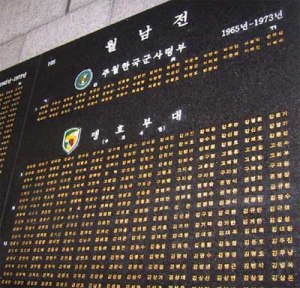
The names of the Korean Killed In Action (KIA) in Vietnam are engraved on black marble stone, classified by units to which the deceased belonged during the Vietnam War, at the Korean War Memorial, Seoul, ROK. Presented by Vietnam Veterans of Korea.
Australia
Australia, as an ally of the United States with obligations under the Southeast Asia Treaty Organization (SEATO) and ANZUS Pacts, and in the hope of shoring up its alliance with the US, became involved in the Vietnam War. Between 1962 and 1972 it would send almost 60,000 personnel to Vietnam, including ground troops, naval forces and air assets, and would contribute large amounts of material to the war effort. Australian Government had introduced a military draft for 20-year-olds, in November 1964,
The Australian military had gained experience in counterinsurgency and jungle warfare during battles in Malaysia and World War II. The United States was looking forward to training they hoped to get from these warriors.
Australia also believed in the Domino Theory and began sending advisors to Vietnam in 1962, and combat troops were committed in 1965.

Personnel and aircraft of RAAF Transport Flight Vietnam arrive in South Vietnam in August 1964

An Australian soldier in Vietnam

Australian soldiers from 7 RAR waiting to be picked up by US Army helicopters following a cordon and search operation near Phuoc Hai in 1967
From an Australian perspective, one of the most famous engagements in the war was the Battle of Long Tan which took place on 18 and 19 August 1966. During the battle a company from 6 RAR, despite being heavily outnumbered, fought off a large enemy assault of regimental strength. 18 Australians were killed and 24 wounded, while at least 245 Viet Cong were killed. It was a decisive Australian victory and is often cited as an example of the importance of combining and coordinating infantry, artillery, armor and military aviation. I recently posted an article about the battle at Long Tan on my website – look to the right column for a link to it.
The withdrawal of Australia’s forces from South Vietnam began in November 1970 when 8 RAR completed its tour of duty and was not replaced. A phased withdrawal followed, and by 11 January 1973 Australian involvement in hostilities in Vietnam had ceased. Nevertheless, Australian troops from the Australian Embassy Platoon remained deployed in the country until 1 July 1973, and Australian forces were deployed briefly in April 1975, during the Fall of Saigon, to evacuate personnel from the Australian embassy. Approximately 60,000 Australians served in the war; 521 were killed and more than 3,000 were wounded
New Zealand
New Zealand decided to send troops to Vietnam in 1965 because of Cold War concerns and alliance considerations. New Zealand began sending troops in 1965 by sending a detachment of engineers and an artillery battery, and then started sending special forces and regular infantry which were attached to Australian formations.
161 Battery was initially under command of the United States Army’s 173rd Airborne Brigade for the first 12 months based at Bien Hoa near Saigon, but would later serve with Royal Australian Artillery field regiments when it was reassigned to the newly formed 1st Australian Task Force at Nui Dat, in Phuoc Tuy Province east of Saigon in June 1966.
The gunners were noted for their key role in assisting the 6th Battalion, Royal Australian Regiment, during the Battle of Long Tan, in which 18 Australians were killed holding off a regimental sized enemy force on 18 August 1966. The battery also played important roles during the Tet Offensive and the Battle of Coral–Balmoral in 1968. The Battery left Vietnam in May 1971 after providing virtually continuous fire support usually in support of Australian and New Zealand infantry units for six years, with 750 men having served with the Battery.

“MEMBERS OF ROYAL NEW ZEALAND ARTILLERY carry out a fire mission.”
Approximately 3,500 New Zealanders served in Vietnam, with 37 killed and 187 wounded. Most Australians and New Zealanders served in the 1st Australian Task Force in Phước Tuy Province.
Philippines
Some 10,450 Filipino troops were dispatched to South Vietnam. They were primarily engaged in medical and other civilian pacification projects. These forces operated under the designation PHLCAG-V or Philippine Civic Action Group-Vietnam. More noteworthy was the fact that the naval base in Subic Bay was used for the U.S. Seventh Fleet from 1964 till the end of the war in 1975. The Navy base in Subic bay and the Air force base at Clark achieved maximum functionality during the war and supported an estimated 80,000 locals in allied tertiary businesses from shoe making to prostitution.
The Philippine Civic Action Group entered Vietnam in September 1966, setting up operations in a base camp in Tay Ninh Province northwest of Saigon. The force included an engineer construction battalion, medical and rural community development teams, a security battalion, a field artillery battery, and a logistics and headquarters element.
In agreeing to commit troops, Philippine President Ferdinand Marcos was partially motivated by the desire for financial aid. In return for the military assistance, the United States not only agreed to pay for the deployment and maintenance of the Philippine force, but also granted Marcos several types of military aid, much of it for use in the Philippines rather than in South Vietnam.

Ranger Scouts
Thailand
Thai Army formations, including the “Queen’s Cobra” battalion, saw action in South Vietnam between 1965 and 1971. Thai forces saw much more action in the covert war in Laos between 1964 and 1972, though Thai regular formations there were heavily outnumbered by the irregular “volunteers” of the CIA-sponsored Police Aerial Reconnaissance Units or PARU, who carried out reconnaissance activities on the western side of the Ho Chi Minh trail.
During the war in Vietnam, Thailand was a close American ally. Although the Thais had customarily gotten along with the Vietnamese, they were dubious of Communist intentions, feared the fall of Cambodia and Laos to guerrillas, and wanted above all else to safeguard their independence. By 1969, the Thais had a total of nearly 12,000 combat troops in Vietnam, including the elite Queen’s Cobras and the Black Panther Division of the Royal Thai Army Volunteer Force. The United States 46th Special Forces Company assisted Thai forces in resisting Communist guerrilla activity along the Laotian border and in the south on the Malay Peninsula. The last of the Thai troops left Vietnam in April 1972.
 The Thai Queen’s Cobra battalion in Phuoc Tho
The Thai Queen’s Cobra battalion in Phuoc Tho
The United States also had a formidable military presence in Thailand, including the 8th, 355th, 366th, and 388th Tactical Fighter Wings and the 307th Strategic Wing. Strategic bombing operations over North and South Vietnam frequently originated in Thailand.
Republic of China (Taiwan)
Two political warfare advisers were stationed in each of the four corps tactical zones, three advisers at the Republic of Vietnam Armed Forces Political Warfare College in Dalat, and the other three with the Armed Forces General Political Warfare Directorate in Saigon. Sponsored and supported by the US Agency for International Development, the seven-member provincial health assistance team worked in the provincial hospital at Phan Thiet. The Republic of China also provided two C46 aircraft and crews for refugee relief missions in South Vietnam. By the end of 1965 assistance from the Republic of China had been increased to include eighty-six agricultural experts and a nine-man mission to supervise construction and operation of the 33,000-kilowatt power plant located at Thu Duc.
Additional aid was sought from the republic early in 1966 when the United States requested six LST’s for service in South Vietnam. Originally given to the Nationalists under the US Military Assistance Program, the ships were to be manned by Chinese crews in civilian clothing and fly US flags. The United States would bear the cost of crew wages and ship maintenance. The mission of the ships was to fill the need for shallow-draft coastal vessels and help ease harbor congestion. The Republic of China was able to provide only two ships; their transfer took place in April in a low key atmosphere without publicity.
Since November 1967, the ROC secretly operated a cargo transport detachment to assist the US and the ROV. It was based on existing formation of the 34th squadron of ROC Air force. The unit’s strength included two cargo aircraft, seven flight officers and two mechanics, even though a higher number of military personnel was involved through rotation. It was tasked with air transportation, airdrop and electronic reconnaissance. Some 25 members of the unit were killed, among them 17 pilots and co-pilots, and three aircraft were lost. Other ROC involvement in Vietnam included a secret listening station, special reconnaissance and raiding squads, military advisers and civilian airline operations (which cost a further two aircraft due to Vietnamese individually operated AA missiles).
The ROC also provided military training units for the South Vietnamese diving units. The ROC trained units would eventually become the Lien Doi Nguoi Nhai (LDMN) or Frogman unit in English. In addition to the diving trainers there were several hundred military personnel. Military commandos from the ROC were captured by communist forces three times, on July 16, 1961 July 1963 and again on October 23, 1963, trying to infiltrate North Vietnam.
Spain’s Secret role
“The expedition was a secret because Franco didn’t want military ties with the United States, and much less wanted to be seen to be supporting Washington’s unilateral war against Vietnam,” says General Antonio Velázquez Rivera, then a 25-year-old lieutenant with the army medical corps. “Vietnam was the first war to be televised, and was soon being cursed around the globe,” he adds.
The first group of medical soldiers, including four doctors, seven nurses and one officer in charge of military supplies, arrived in Vietnam in 1966 and worked at Truong Cong Dinh hospital in the Go Gong district, about 45 kilometers from the capital, Saigon. From 1966 to 1971 three other groups, totaling nearly 100 Spaniards, worked at the hospital.
To avoid being seen to be publicly supporting the United States, General Franco ordered the medics to keep their activities secret. The soldiers, who completed their mission in 1971, were told to remain silent. The secret of the Spanish intervention in Vietnam was discovered by journalist Alejandro Ramírez, who published a book about it in 2005, and which was the basis for the documentary film.

In December 1965 the government of Spain announced that as a result of a request by the government of Vietnam, it would provide a medical mission of twelve to fourteen men to the Republic of Vietnam. Negotiations over support arrangements were made in co-ordination with the U.S. Agency for International Development and the Vietnamese Minister of Health. The major points of this arrangement were that the government of Spain would pay the team’s salaries and allowance, plus fifty dollars a month per member for subsistence, and the United States would pay all other costs.
It was decided to locate the team of four doctors, one quartermaster, a captain, and seven nurses in Go Cong Province in the IV Corps Tactical Zone. The team arrived in Vietnam on 8 September and on 10 September it replaced the US Military Provincial Health Assistance Program team at the province hospital in Go Cong.
*****
Support to North Vietnam
China
In 1965, China sent anti-aircraft units and engineering battalions to North Vietnam to repair the damage caused by American bombing, man anti-aircraft batteries, rebuild roads and railroads, transport supplies, and perform other engineering works. This freed North Vietnamese army units for combat in the South. China sent 320,000 troops and annual arms shipments worth $180 million. The Chinese military claims to have caused 38% of American air losses in the war.

China claimed that its military and economic aid to North Vietnam and the Viet Cong totaled $20 billion (approx. $143 billion adjusted for inflation in 2015) during the Vietnam War. Included in that aid were donations of 5 million tons of food to North Vietnam (equivalent to NV food production in a single year), accounting for 10-15% of the North Vietnamese food supply by the 1970s.
Military aid given to North Vietnam by the People’s Republic of China:
Guns – 1,922,897
Artillery pieces – 64,529
Bullets – 1,048,207,000
Artillery shells – 17,074,000
Radio transmitters – 30,808
Telephones – 48,922
Tanks – 560
Planes – 164
Automobiles – 15,771
Soviet Union

Leonid Brezhnev (left) was the leader of the Soviet Union during the second half of the Vietnam War
Soviet ships in the South China Sea gave vital early warnings to Viet Cong forces in South Vietnam. The Soviet intelligence ships would pick up American B-52 bombers flying from Okinawa and Guam. Their airspeed and direction would be noted and then relayed to COSVN, North Vietnam’s southern headquarters. Using airspeed and direction, COSVN analysts would calculate the bombing target and tell any assets to move “perpendicularly to the attack trajectory.” These advance warning gave them time to move out of the way of the bombers, and, while the bombing runs caused extensive damage, because of the early warnings from 1968 to 1970 they did not kill a single military or civilian leader in the headquarters complexes.

The Soviet Union supplied North Vietnam with medical supplies, arms, tanks, planes, helicopters, artillery, anti-aircraft missiles and other military equipment. Soviet crews fired Soviet-made surface-to-air missiles at U.S. F-4 Phantoms, which were shot down over Thanh Hóa in 1965. Over a dozen Soviet citizens lost their lives in this conflict. Following the collapse of the Soviet Union in 1991, Russian officials acknowledged that the Soviet Union had stationed up to 3,000 troops in Vietnam during the war.
Some Russian sources give more specific numbers: Between 1953 and 1991, the hardware donated by the Soviet Union included:
Tanks – 2000
APCs – 1700
Artillery guns – 7000
Anti-aircraft guns – 5000
Surface-to-air missile launchers – 158,
Helicopters – 120
During the war, the Soviets sent North Vietnam annual arms shipments worth $450 million. From July 1965 to the end of 1974, fighting in Vietnam was observed by some 6,500 officers and generals, as well as more than 4,500 soldiers and sergeants of the Soviet Armed Forces. In addition, Soviet military schools and academies began training Vietnamese soldiers – in all more than 10,000 military personnel.
North Korea
As a result of a decision of the Korean Workers’ Party in October 1966, in early 1967 North Korea sent a fighter squadron to North Vietnam to back up the North Vietnamese 921st and 923rd fighter squadrons defending Hanoi. They stayed through 1968, and 200 pilots were reported to have served.
In addition, at least two anti-aircraft artillery regiments were sent as well. North Korea also sent weapons, ammunition and two million sets of uniforms to their comrades in North Vietnam. Kim Il-sung is reported to have told his pilots to “fight in the war as if the Vietnamese sky were their own”.
Cuba
The contribution to North Vietnam by the Republic of Cuba, under Fidel Castro have been recognized several times by representatives of the Democratic Republic of Vietnam. Fidel Castro has mentioned in his discourses the Batallón Girón (Giron Battalion) as comprising the Cuban contingent that served as military advisors during the war.
In this battalion, alongside the Cubans, fought Nguyễn Thị Định, founding member of the Viet Cong, who later became the first female Major General in the North Vietnamese Army.
There are numerous allegations by former U.S. prisoners of war that Cuban military personnel were present at North Vietnamese prison facilities during the war and that they participated in torture activities, in what is known as the “Cuba Program Witnesses to this include Senator John McCain, former Vietnam prisoner of war, according to his 1999 book Faith of My Fathers Benjamin Gilman, a Vietnam War POW/MIA issue advocate, claim evidence that Cuba’s military and non-military involvement may have run into the “thousands” of personnel. Fidel Castro visited Quảng Trị province, held by North Vietnam after the Easter Offensive to show his support for the Viet Cong.
So there you have it. I hope you were able to learn something new about the Vietnam War. Personally, the only other forces I saw during my tour was the Aussies who hung out around Xaun Loc and the Iron Triangle. Used to pass them on roads when they filed by in APC’s. Anybody else recall seeing fighters from other countries while serving in Vietnam. I think this article also answers one of my earlier question about seeing a blond hair Caucasian running with enemy soldiers (Russian perhaps?). Thank you for taking the time to read through this. Any comments?
Information used in this article was obtained from: TalkingProud.us; War History Online; Answers.com; NZhistory.net; militaryhistoryonline.
Original Content / Credit:
https://cherrieswriter.com/2016/07/19/who-were-all-the-players-during-the-vietnam-war/.


